Spring MVC 源码深度剖析
1. Spring MVC 执行流程
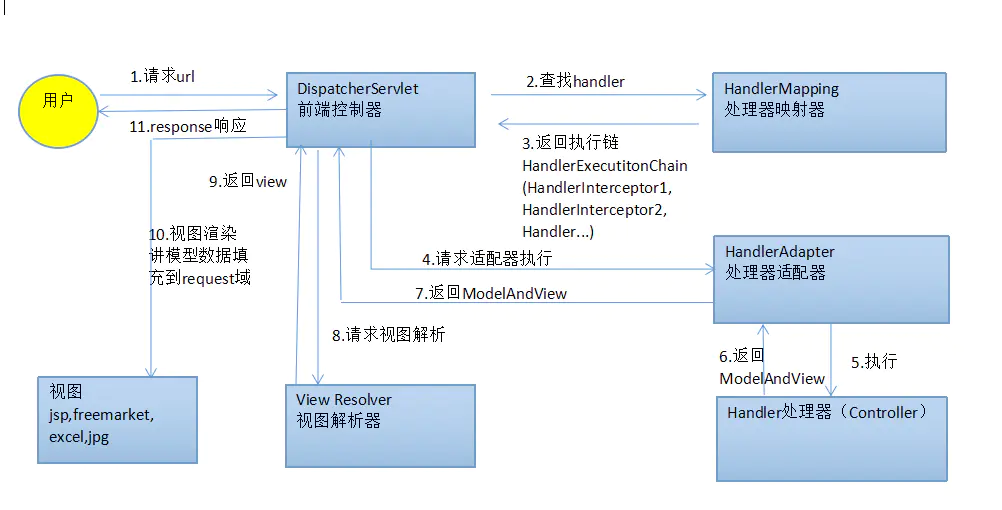
2. 前端控制器 DispatcherServlet 继承结构
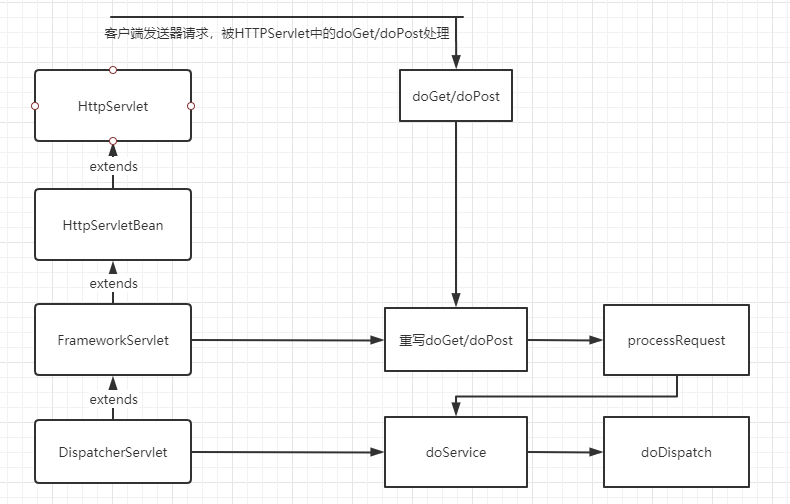
3. doDispatch() 方法分析
3.1 handler方法的执行时机
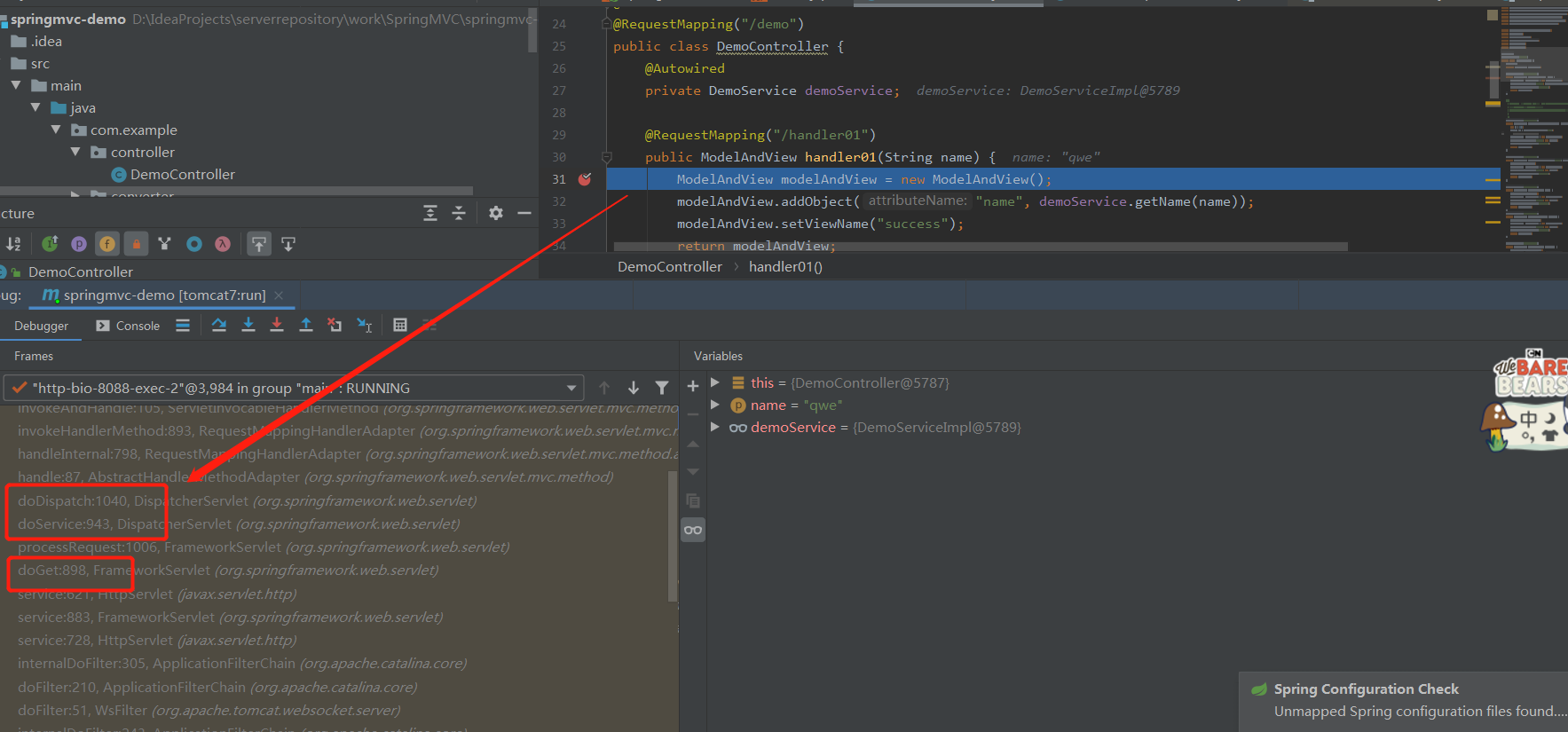
3.2 源码分析
/**
* Process the actual dispatching to the handler.
* <p>The handler will be obtained by applying the servlet's HandlerMappings in order.
* The HandlerAdapter will be obtained by querying the servlet's installed HandlerAdapters
* to find the first that supports the handler class.
* <p>All HTTP methods are handled by this method. It's up to HandlerAdapters or handlers
* themselves to decide which methods are acceptable.
* @param request current HTTP request
* @param response current HTTP response
* @throws Exception in case of any kind of processing failure
*/
protected void doDispatch(HttpServletRequest request, HttpServletResponse response) throws Exception {
HttpServletRequest processedRequest = request;
// 定义处理器执行器链
HandlerExecutionChain mappedHandler = null;
// 是否为多文件请求
boolean multipartRequestParsed = false;
// 获取异步管理器
WebAsyncManager asyncManager = WebAsyncUtils.getAsyncManager(request);
try {
// 定义ModelAndView
ModelAndView mv = null;
// 定义异常处理器
Exception dispatchException = null;
try {
// 是否为多文件请求 判断
processedRequest = checkMultipart(request);
multipartRequestParsed = (processedRequest != request);
// Determine handler for the current request.
// 通过request中的URI取得处理当前请求的Controller,这里也称为Handler,即处理器
// 这里并不是直接返回 Controller,而是返回 HandlerExecutionChain 请求处理链对象
// 该对象封装了Handler和Inteceptor
mappedHandler = getHandler(processedRequest);
if (mappedHandler == null) {
// 如果 handler 为空,则返回404
noHandlerFound(processedRequest, response);
return;
}
// Determine handler adapter for the current request.
// 通过处理器链获取处理器适配器
HandlerAdapter ha = getHandlerAdapter(mappedHandler.getHandler());
// Process last-modified header, if supported by the handler.
// 获取请求方法 处理 last-modified 请求头
String method = request.getMethod();
boolean isGet = "GET".equals(method);
if (isGet || "HEAD".equals(method)) {
long lastModified = ha.getLastModified(request, mappedHandler.getHandler());
if (new ServletWebRequest(request, response).checkNotModified(lastModified) && isGet) {
return;
}
}
if (!mappedHandler.applyPreHandle(processedRequest, response)) {
return;
}
// Actually invoke the handler.
// 执行具体的handler方法 返回一个视图对象
mv = ha.handle(processedRequest, response, mappedHandler.getHandler());
if (asyncManager.isConcurrentHandlingStarted()) {
return;
}
// 处理结果视图对象
applyDefaultViewName(processedRequest, mv);
// 执行拦截器中的postHandle
mappedHandler.applyPostHandle(processedRequest, response, mv);
}
catch (Exception ex) {
dispatchException = ex;
}
catch (Throwable err) {
// As of 4.3, we're processing Errors thrown from handler methods as well,
// making them available for @ExceptionHandler methods and other scenarios.
dispatchException = new NestedServletException("Handler dispatch failed", err);
}
// 跳转页面 渲染视图
processDispatchResult(processedRequest, response, mappedHandler, mv, dispatchException);
}
catch (Exception ex) {
triggerAfterCompletion(processedRequest, response, mappedHandler, ex);
}
catch (Throwable err) {
triggerAfterCompletion(processedRequest, response, mappedHandler,
new NestedServletException("Handler processing failed", err));
}
finally {
if (asyncManager.isConcurrentHandlingStarted()) {
// Instead of postHandle and afterCompletion
if (mappedHandler != null) {
mappedHandler.applyAfterConcurrentHandlingStarted(processedRequest, response);
}
}
else {
// Clean up any resources used by a multipart request.
if (multipartRequestParsed) {
cleanupMultipart(processedRequest);
}
}
}
}
3.3 获取handler方法分析getHandler(processedRequest)
通过遍历handlerMappings集合,获取能够处理当前请求的处理器
/**
* Return the HandlerExecutionChain for this request.
* <p>Tries all handler mappings in order.
* @param request current HTTP request
* @return the HandlerExecutionChain, or {@code null} if no handler could be found
*/
@Nullable
protected HandlerExecutionChain getHandler(HttpServletRequest request) throws Exception {
if (this.handlerMappings != null) {
for (HandlerMapping mapping : this.handlerMappings) {
HandlerExecutionChain handler = mapping.getHandler(request);
if (handler != null) {
return handler;
}
}
}
return null;
}
this.handlerMappings中默认会初始化两个handlerMapping
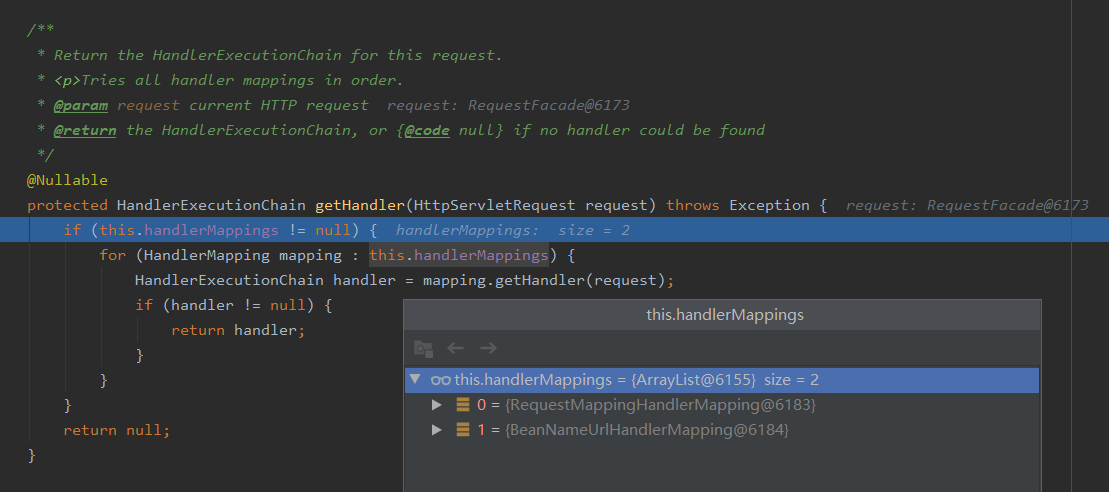
- BeanNameUrlHandlerMapping 通过URL的名称和Handler方法的名称进行匹配
public class BeanNameUrlHandlerMapping extends AbstractDetectingUrlHandlerMapping
- RequestMappingHandlerMapping 通过URL的名称和@RequestMapping注解 的value进行匹配
public class RequestMappingHandlerMapping extends RequestMappingInfoHandlerMapping
implements MatchableHandlerMapping, EmbeddedValueResolverAware
3.4 获取适配器方法getHandlerAdapter()
遍历各个HandlerAdapter,看哪个Adapter⽀持处理当前Handler
/**
* Return the HandlerAdapter for this handler object.
* @param handler the handler object to find an adapter for
* @throws ServletException if no HandlerAdapter can be found for the handler. This is a fatal error.
*/
protected HandlerAdapter getHandlerAdapter(Object handler) throws ServletException {
if (this.handlerAdapters != null) {
for (HandlerAdapter adapter : this.handlerAdapters) {
if (adapter.supports(handler)) {
return adapter;
}
}
}
throw new ServletException("No adapter for handler [" + handler +
"]: The DispatcherServlet configuration needs to include a HandlerAdapter that supports this handler");
}
默认初始化三个Adapter
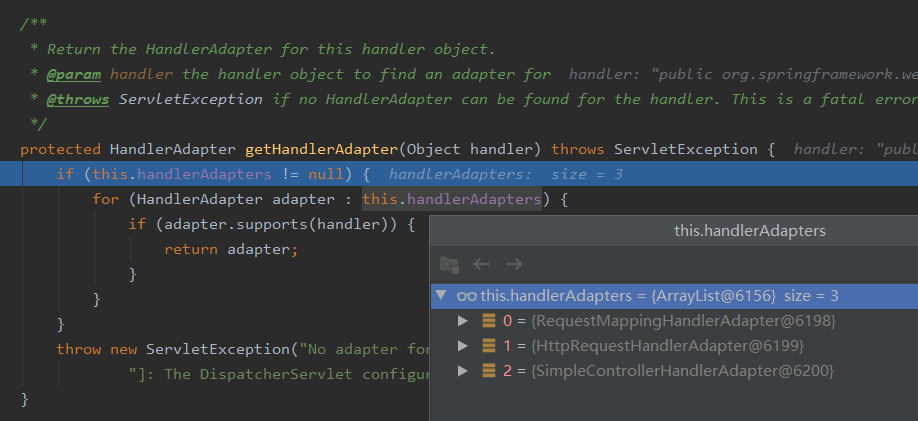
- RequestMappingHandlerAdapter: 使用@Controller注解,并且使用@RequestMapping来进行url和方法映射后,使用这个Adapter处理
- HttpRequestHandlerAdapter: 处理实现了HttpReqeustHandler接口的controller
- SimpleControllerHandlerAdapter: 处理实现了Controller接口的类
3.5 具体处理handler方法ha.handle(...);
- AbstractHandlerMethodAdapter#handle
/**
* This implementation expects the handler to be an {@link HandlerMethod}.
*/
@Override
@Nullable
public final ModelAndView handle(HttpServletRequest request, HttpServletResponse response, Object handler)
throws Exception {
return handleInternal(request, response, (HandlerMethod) handler);
}
- RequestMappingHandlerAdapter#handleInternal
@Override
protected ModelAndView handleInternal(HttpServletRequest request,
HttpServletResponse response, HandlerMethod handlerMethod) throws Exception {
ModelAndView mav;
checkRequest(request);
// Execute invokeHandlerMethod in synchronized block if required.
// 判断当前是否需要支持在同一个session中线性的处理请求
if (this.synchronizeOnSession) {
HttpSession session = request.getSession(false);
if (session != null) {
// 为当前session生成一个唯一的用于锁定的key
Object mutex = WebUtils.getSessionMutex(session);
synchronized (mutex) {
// 对参数进行处理 并调用方法
mav = invokeHandlerMethod(request, response, handlerMethod);
}
}
else {
// No HttpSession available -> no mutex necessary
mav = invokeHandlerMethod(request, response, handlerMethod);
}
}
else {
// No synchronization on session demanded at all...
// 不需要同步处理 直接对参数进行处理 并调用方法
mav = invokeHandlerMethod(request, response, handlerMethod);
}
if (!response.containsHeader(HEADER_CACHE_CONTROL)) {
if (getSessionAttributesHandler(handlerMethod).hasSessionAttributes()) {
applyCacheSeconds(response, this.cacheSecondsForSessionAttributeHandlers);
}
else {
prepareResponse(response);
}
}
return mav;
}
- RequestMappingHandlerAdapter#invokeHandlerMethod
/**
* Invoke the {@link RequestMapping} handler method preparing a {@link ModelAndView}
* if view resolution is required.
* @since 4.2
* @see #createInvocableHandlerMethod(HandlerMethod)
*/
@Nullable
protected ModelAndView invokeHandlerMethod(HttpServletRequest request,
HttpServletResponse response, HandlerMethod handlerMethod) throws Exception {
ServletWebRequest webRequest = new ServletWebRequest(request, response);
try {
// 省略部分代码
.......
if (asyncManager.hasConcurrentResult()) {
Object result = asyncManager.getConcurrentResult();
mavContainer = (ModelAndViewContainer) asyncManager.getConcurrentResultContext()[0];
asyncManager.clearConcurrentResult();
LogFormatUtils.traceDebug(logger, traceOn -> {
String formatted = LogFormatUtils.formatValue(result, !traceOn);
return "Resume with async result [" + formatted + "]";
});
invocableMethod = invocableMethod.wrapConcurrentResult(result);
}
// 执行方法并返回一个ModelAndView容器对象
invocableMethod.invokeAndHandle(webRequest, mavContainer);
if (asyncManager.isConcurrentHandlingStarted()) {
return null;
}
// 通过容器中的视图名称、参数、状态等信息初始化一个ModelAndView对象
return getModelAndView(mavContainer, modelFactory, webRequest);
}
finally {
webRequest.requestCompleted();
}
}
- ServletInvocableHandlerMethod#invokeAndHandle
/**
* Invoke the method and handle the return value through one of the
* configured {@link HandlerMethodReturnValueHandler HandlerMethodReturnValueHandlers}.
* @param webRequest the current request
* @param mavContainer the ModelAndViewContainer for this request
* @param providedArgs "given" arguments matched by type (not resolved)
*/
public void invokeAndHandle(ServletWebRequest webRequest, ModelAndViewContainer mavContainer,
Object... providedArgs) throws Exception {
Object returnValue = invokeForRequest(webRequest, mavContainer, providedArgs);
setResponseStatus(webRequest);
if (returnValue == null) {
if (isRequestNotModified(webRequest) || getResponseStatus() != null || mavContainer.isRequestHandled()) {
disableContentCachingIfNecessary(webRequest);
mavContainer.setRequestHandled(true);
return;
}
}
else if (StringUtils.hasText(getResponseStatusReason())) {
mavContainer.setRequestHandled(true);
return;
}
mavContainer.setRequestHandled(false);
Assert.state(this.returnValueHandlers != null, "No return value handlers");
try {
this.returnValueHandlers.handleReturnValue(
returnValue, getReturnValueType(returnValue), mavContainer, webRequest);
}
catch (Exception ex) {
if (logger.isTraceEnabled()) {
logger.trace(formatErrorForReturnValue(returnValue), ex);
}
throw ex;
}
}
- InvocableHandlerMethod#invokeForRequest
@Nullable
public Object invokeForRequest(NativeWebRequest request, @Nullable ModelAndViewContainer mavContainer,
Object... providedArgs) throws Exception {
// 对参数进行处理
Object[] args = getMethodArgumentValues(request, mavContainer, providedArgs);
if (logger.isTraceEnabled()) {
logger.trace("Arguments: " + Arrays.toString(args));
}
// 结合处理后的参数,通过反射执行方法
return doInvoke(args);
}
3.6 跳转页面 渲染视图processDispatchResult⽅法剖析
1. processDispatchResult
/**
* Handle the result of handler selection and handler invocation, which is
* either a ModelAndView or an Exception to be resolved to a ModelAndView.
*/
private void processDispatchResult(HttpServletRequest request, HttpServletResponse response,
@Nullable HandlerExecutionChain mappedHandler, @Nullable ModelAndView mv,
@Nullable Exception exception) throws Exception {
// 异常页面
boolean errorView = false;
if (exception != null) {
if (exception instanceof ModelAndViewDefiningException) {
logger.debug("ModelAndViewDefiningException encountered", exception);
mv = ((ModelAndViewDefiningException) exception).getModelAndView();
}
else {
Object handler = (mappedHandler != null ? mappedHandler.getHandler() : null);
// 异常处理器
mv = processHandlerException(request, response, handler, exception);
errorView = (mv != null);
}
}
// Did the handler return a view to render?
if (mv != null && !mv.wasCleared()) {
// 渲染视图
render(mv, request, response);
if (errorView) {
WebUtils.clearErrorRequestAttributes(request);
}
}
else {
if (logger.isTraceEnabled()) {
logger.trace("No view rendering, null ModelAndView returned.");
}
}
if (WebAsyncUtils.getAsyncManager(request).isConcurrentHandlingStarted()) {
// Concurrent handling started during a forward
return;
}
if (mappedHandler != null) {
mappedHandler.triggerAfterCompletion(request, response, null);
}
}
2. render()
protected void render(ModelAndView mv, HttpServletRequest request, HttpServletResponse response) throws Exception {
// Determine locale for request and apply it to the response.
// 设置国际化
Locale locale =
(this.localeResolver != null ? this.localeResolver.resolveLocale(request) : request.getLocale());
response.setLocale(locale);
View view;
// 获取视图名称
String viewName = mv.getViewName();
if (viewName != null) {
// We need to resolve the view name.
// 通过视图解析器获取完整的视图名称
view = resolveViewName(viewName, mv.getModelInternal(), locale, request);
if (view == null) {
throw new ServletException("Could not resolve view with name '" + mv.getViewName() +
"' in servlet with name '" + getServletName() + "'");
}
}
else {
// No need to lookup: the ModelAndView object contains the actual View object.
// 如果视图名称为空 将请求的路径作为视图名称
view = mv.getView();
if (view == null) {
throw new ServletException("ModelAndView [" + mv + "] neither contains a view name nor a " +
"View object in servlet with name '" + getServletName() + "'");
}
}
// Delegate to the View object for rendering.
if (logger.isTraceEnabled()) {
logger.trace("Rendering view [" + view + "] ");
}
try {
if (mv.getStatus() != null) {
response.setStatus(mv.getStatus().value());
}
// 调用view的render方法
view.render(mv.getModelInternal(), request, response);
}
catch (Exception ex) {
if (logger.isDebugEnabled()) {
logger.debug("Error rendering view [" + view + "]", ex);
}
throw ex;
}
}
3. 通过视图解析器获取完整视图名称DispatcherServlet#resolveViewName

4. 执行视图解析器的方法AbstractCachingViewResolver#resolveViewName
@Override
@Nullable
public View resolveViewName(String viewName, Locale locale) throws Exception {
// 如果有缓存 直接使用缓存创建视图
if (!isCache()) {
return createView(viewName, locale);
}
else {
// 获取当前视图的缓存key return viewName + '_' + locale;
Object cacheKey = getCacheKey(viewName, locale);
// 从视图缓存中获取
View view = this.viewAccessCache.get(cacheKey);
if (view == null) {
synchronized (this.viewCreationCache) {
view = this.viewCreationCache.get(cacheKey);
if (view == null) {
// Ask the subclass to create the View object.
// 创建视图
view = createView(viewName, locale);
if (view == null && this.cacheUnresolved) {
view = UNRESOLVED_VIEW;
}
if (view != null) {
// 存入缓存
this.viewAccessCache.put(cacheKey, view);
this.viewCreationCache.put(cacheKey, view);
}
}
}
}
else {
if (logger.isTraceEnabled()) {
logger.trace(formatKey(cacheKey) + "served from cache");
}
}
return (view != UNRESOLVED_VIEW ? view : null);
}
}
5. 创建视图UrlBasedViewResolver#createView
@Override
protected View createView(String viewName, Locale locale) throws Exception {
// If this resolver is not supposed to handle the given view,
// return null to pass on to the next resolver in the chain.
// 判断当前解析器能否处理当前视图
if (!canHandle(viewName, locale)) {
return null;
}
// Check for special "redirect:" prefix.
// 判断是否是重定向
if (viewName.startsWith(REDIRECT_URL_PREFIX)) {
String redirectUrl = viewName.substring(REDIRECT_URL_PREFIX.length());
RedirectView view = new RedirectView(redirectUrl,
isRedirectContextRelative(), isRedirectHttp10Compatible());
String[] hosts = getRedirectHosts();
if (hosts != null) {
view.setHosts(hosts);
}
return applyLifecycleMethods(REDIRECT_URL_PREFIX, view);
}
// Check for special "forward:" prefix.
// 判断是否是转发
if (viewName.startsWith(FORWARD_URL_PREFIX)) {
String forwardUrl = viewName.substring(FORWARD_URL_PREFIX.length());
InternalResourceView view = new InternalResourceView(forwardUrl);
return applyLifecycleMethods(FORWARD_URL_PREFIX, view);
}
// Else fall back to superclass implementation: calling loadView.
return super.createView(viewName, locale);
}
6. UrlBasedViewResolver#loadView
@Override
protected View loadView(String viewName, Locale locale) throws Exception {
AbstractUrlBasedView view = buildView(viewName);
View result = applyLifecycleMethods(viewName, view);
return (view.checkResource(locale) ? result : null);
}
7. InternalResourceViewResolver#buildView
@Override
protected AbstractUrlBasedView buildView(String viewName) throws Exception {
InternalResourceView view = (InternalResourceView) super.buildView(viewName);
if (this.alwaysInclude != null) {
view.setAlwaysInclude(this.alwaysInclude);
}
view.setPreventDispatchLoop(true);
return view;
}
8. UrlBasedViewResolver#buildView
protected AbstractUrlBasedView buildView(String viewName) throws Exception {
Class<?> viewClass = getViewClass();
Assert.state(viewClass != null, "No view class");
AbstractUrlBasedView view = (AbstractUrlBasedView) BeanUtils.instantiateClass(viewClass);
// 通过视图解析器中的前缀和后缀拼接视图全名称
view.setUrl(getPrefix() + viewName + getSuffix());
String contentType = getContentType();
if (contentType != null) {
view.setContentType(contentType);
}
view.setRequestContextAttribute(getRequestContextAttribute());
view.setAttributesMap(getAttributesMap());
Boolean exposePathVariables = getExposePathVariables();
if (exposePathVariables != null) {
view.setExposePathVariables(exposePathVariables);
}
Boolean exposeContextBeansAsAttributes = getExposeContextBeansAsAttributes();
if (exposeContextBeansAsAttributes != null) {
view.setExposeContextBeansAsAttributes(exposeContextBeansAsAttributes);
}
String[] exposedContextBeanNames = getExposedContextBeanNames();
if (exposedContextBeanNames != null) {
view.setExposedContextBeanNames(exposedContextBeanNames);
}
return view;
}
9. 调用view.render() AbstractView#render
@Override
public void render(@Nullable Map<String, ?> model, HttpServletRequest request,
HttpServletResponse response) throws Exception {
if (logger.isDebugEnabled()) {
logger.debug("View " + formatViewName() +
", model " + (model != null ? model : Collections.emptyMap()) +
(this.staticAttributes.isEmpty() ? "" : ", static attributes " + this.staticAttributes));
}
// 从model、request、 response获取准备渲染的数据
Map<String, Object> mergedModel = createMergedOutputModel(model, request, response);
// 准备渲染
prepareResponse(request, response);
// 渲染数据
renderMergedOutputModel(mergedModel, getRequestToExpose(request), response);
}
10. 渲染数据 InternalResourceView#renderMergedOutputModel
@Override
protected void renderMergedOutputModel(
Map<String, Object> model, HttpServletRequest request, HttpServletResponse response) throws Exception {
// Expose the model object as request attributes.
// 将每个属性添加到request域中
/**
* protected void exposeModelAsRequestAttributes(Map<String, Object> model,
* HttpServletRequest request) throws Exception {
*
* model.forEach((name, value) -> {
* if (value != null) {
* request.setAttribute(name, value);
* }
* else {
* request.removeAttribute(name);
* }* });* }
*/
exposeModelAsRequestAttributes(model, request);
// Expose helpers as request attributes, if any.
exposeHelpers(request);
// Determine the path for the request dispatcher.
String dispatcherPath = prepareForRendering(request, response);
// Obtain a RequestDispatcher for the target resource (typically a JSP).
RequestDispatcher rd = getRequestDispatcher(request, dispatcherPath);
if (rd == null) {
throw new ServletException("Could not get RequestDispatcher for [" + getUrl() +
"]: Check that the corresponding file exists within your web application archive!");
}
// If already included or response already committed, perform include, else forward.
if (useInclude(request, response)) {
response.setContentType(getContentType());
if (logger.isDebugEnabled()) {
logger.debug("Including [" + getUrl() + "]");
}
rd.include(request, response);
}
else {
// Note: The forwarded resource is supposed to determine the content type itself.
if (logger.isDebugEnabled()) {
logger.debug("Forwarding to [" + getUrl() + "]");
}
rd.forward(request, response);
}
}
4. SpringMVC九⼤组件初始化
4.1 在DispatcherServlet中定义了九个属性,每⼀个属性都对应⼀种组件
/** MultipartResolver used by this servlet. */
// 多部位解析器
@Nullable
private MultipartResolver multipartResolver;
/** LocaleResolver used by this servlet. */
// 国际化解析器
@Nullable
private LocaleResolver localeResolver;
/** ThemeResolver used by this servlet. */
// 主题解析器
@Nullable
private ThemeResolver themeResolver;
/** List of HandlerMappings used by this servlet. */
// 处理器映射器
@Nullable
private List<HandlerMapping> handlerMappings;
/** List of HandlerAdapters used by this servlet. */
// 处理器适配器
@Nullable
private List<HandlerAdapter> handlerAdapters;
/** List of HandlerExceptionResolvers used by this servlet. */
// 异常解析器
@Nullable
private List<HandlerExceptionResolver> handlerExceptionResolvers;
/** RequestToViewNameTranslator used by this servlet. */
// 默认视图名称转换器
@Nullable
private RequestToViewNameTranslator viewNameTranslator;
/** FlashMapManager used by this servlet. */
// flash属性管理器 重定向或者转发时通过flash携带参数 解决不安全问题和参数大小限制问题
@Nullable
private FlashMapManager flashMapManager;
/** List of ViewResolvers used by this servlet. */
// 视图解析器
@Nullable
private List<ViewResolver> viewResolvers;
4.2 九大组件的初始化时机
FrameworkServlet#initWebApplicationContext 父类FrameworkServlet在初始化web容器的会调用子类DispatcherServlet实现的onrefresh()
/**
* This implementation calls {@link #initStrategies}.
*/
@Override
protected void onRefresh(ApplicationContext context) {
initStrategies(context);
}
/**
* Initialize the strategy objects that this servlet uses.
* <p>May be overridden in subclasses in order to initialize further strategy objects.
*/
protected void initStrategies(ApplicationContext context) {
initMultipartResolver(context);
initLocaleResolver(context);
initThemeResolver(context);
initHandlerMappings(context);
initHandlerAdapters(context);
initHandlerExceptionResolvers(context);
initRequestToViewNameTranslator(context);
initViewResolvers(context);
initFlashMapManager(context);
}
4.2.1 多部位解析器initMultipartResolver
private void initMultipartResolver(ApplicationContext context) {
try {
// 直接从spring容器中通过ID获取 ID固定为multipartResolver
// public static final String MULTIPART_RESOLVER_BEAN_NAME = "multipartResolver";
this.multipartResolver = context.getBean(MULTIPART_RESOLVER_BEAN_NAME, MultipartResolver.class);
if (logger.isTraceEnabled()) {
logger.trace("Detected " + this.multipartResolver);
}
else if (logger.isDebugEnabled()) {
logger.debug("Detected " + this.multipartResolver.getClass().getSimpleName());
}
}
catch (NoSuchBeanDefinitionException ex) {
// Default is no multipart resolver.
this.multipartResolver = null;
if (logger.isTraceEnabled()) {
logger.trace("No MultipartResolver '" + MULTIPART_RESOLVER_BEAN_NAME + "' declared");
}
}
}
4.2.2 处理器映射器initHandlerMappings
private void initHandlerMappings(ApplicationContext context) {
this.handlerMappings = null;
// 按照HandlerMapping.class 类型在容器中查找所有的HandlerMapping
if (this.detectAllHandlerMappings) {
// Find all HandlerMappings in the ApplicationContext, including ancestor contexts.
Map<String, HandlerMapping> matchingBeans =
BeanFactoryUtils.beansOfTypeIncludingAncestors(context, HandlerMapping.class, true, false);
if (!matchingBeans.isEmpty()) {
this.handlerMappings = new ArrayList<>(matchingBeans.values());
// We keep HandlerMappings in sorted order.
AnnotationAwareOrderComparator.sort(this.handlerMappings);
}
}
// 通过id在容器中查找
// public static final String HANDLER_MAPPING_BEAN_NAME = "handlerMapping";
else {
try {
HandlerMapping hm = context.getBean(HANDLER_MAPPING_BEAN_NAME, HandlerMapping.class);
this.handlerMappings = Collections.singletonList(hm);
}
catch (NoSuchBeanDefinitionException ex) {
// Ignore, we'll add a default HandlerMapping later.
}
}
// Ensure we have at least one HandlerMapping, by registering
// a default HandlerMapping if no other mappings are found.
// 如果还为空 使用策略模式 按照默认策略初始化
if (this.handlerMappings == null) {
this.handlerMappings = getDefaultStrategies(context, HandlerMapping.class);
if (logger.isTraceEnabled()) {
logger.trace("No HandlerMappings declared for servlet '" + getServletName() +
"': using default strategies from DispatcherServlet.properties");
}
}
}
getDefaultStrategies(context, HandlerMapping.class);
/**
* Create a List of default strategy objects for the given strategy interface.
* <p>The default implementation uses the "DispatcherServlet.properties" file (in the same
* package as the DispatcherServlet class) to determine the class names. It instantiates
* the strategy objects through the context's BeanFactory.
* @param context the current WebApplicationContext
* @param strategyInterface the strategy interface
* @return the List of corresponding strategy objects
*/
@SuppressWarnings("unchecked")
protected <T> List<T> getDefaultStrategies(ApplicationContext context, Class<T> strategyInterface) {
String key = strategyInterface.getName();
// 从DispatcherServlet.properties中获取当前bean的class数组
String value = defaultStrategies.getProperty(key);
if (value != null) {
String[] classNames = StringUtils.commaDelimitedListToStringArray(value);
List<T> strategies = new ArrayList<>(classNames.length);
// 实例化每一个class
for (String className : classNames) {
try {
Class<?> clazz = ClassUtils.forName(className, DispatcherServlet.class.getClassLoader());
Object strategy = createDefaultStrategy(context, clazz);
strategies.add((T) strategy);
}
catch (ClassNotFoundException ex) {
throw new BeanInitializationException(
"Could not find DispatcherServlet's default strategy class [" + className +
"] for interface [" + key + "]", ex);
}
catch (LinkageError err) {
throw new BeanInitializationException(
"Unresolvable class definition for DispatcherServlet's default strategy class [" +
className + "] for interface [" + key + "]", err);
}
}
return strategies;
}
else {
return new LinkedList<>();
}
}
DispatcherServlet.properties
# Default implementation classes for DispatcherServlet's strategy interfaces.
# Used as fallback when no matching beans are found in the DispatcherServlet context.
# Not meant to be customized by application developers.
org.springframework.web.servlet.LocaleResolver=org.springframework.web.servlet.i18n.AcceptHeaderLocaleResolver
org.springframework.web.servlet.ThemeResolver=org.springframework.web.servlet.theme.FixedThemeResolver
# 处理器映射器默认初始化两个 BeanNameUrlHandlerMapping和RequestMappingHandlerMapping 对应源码跟踪中看待的两个HandlerMapping
org.springframework.web.servlet.HandlerMapping=org.springframework.web.servlet.handler.BeanNameUrlHandlerMapping,\
org.springframework.web.servlet.mvc.method.annotation.RequestMappingHandlerMapping
# 处理器适配器默认初始化三个 HttpRequestHandlerAdapter、SimpleControllerHandlerAdapter、RequestMappingHandlerAdapter
org.springframework.web.servlet.HandlerAdapter=org.springframework.web.servlet.mvc.HttpRequestHandlerAdapter,\
org.springframework.web.servlet.mvc.SimpleControllerHandlerAdapter,\
org.springframework.web.servlet.mvc.method.annotation.RequestMappingHandlerAdapter
org.springframework.web.servlet.HandlerExceptionResolver=org.springframework.web.servlet.mvc.method.annotation.ExceptionHandlerExceptionResolver,\
org.springframework.web.servlet.mvc.annotation.ResponseStatusExceptionResolver,\
org.springframework.web.servlet.mvc.support.DefaultHandlerExceptionResolver
org.springframework.web.servlet.RequestToViewNameTranslator=org.springframework.web.servlet.view.DefaultRequestToViewNameTranslator
org.springframework.web.servlet.ViewResolver=org.springframework.web.servlet.view.InternalResourceViewResolver
org.springframework.web.servlet.FlashMapManager=org.springframework.web.servlet.support.SessionFlashMapManager